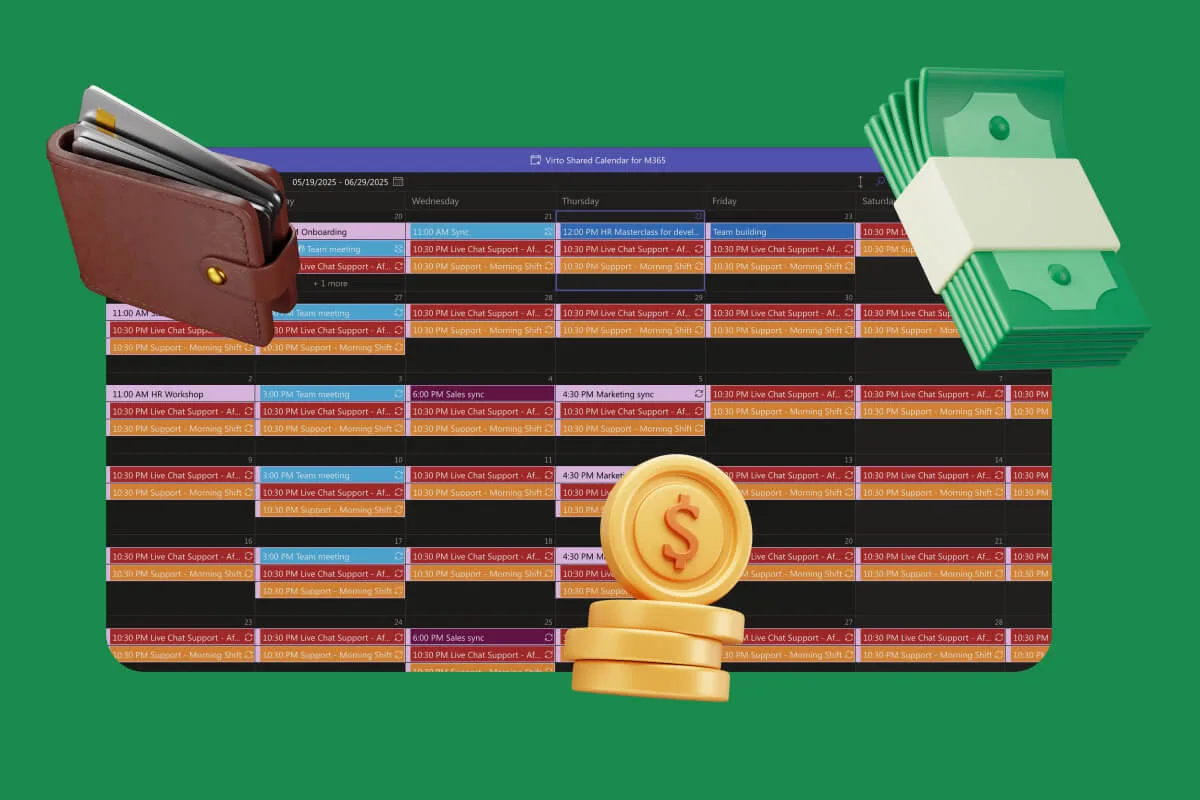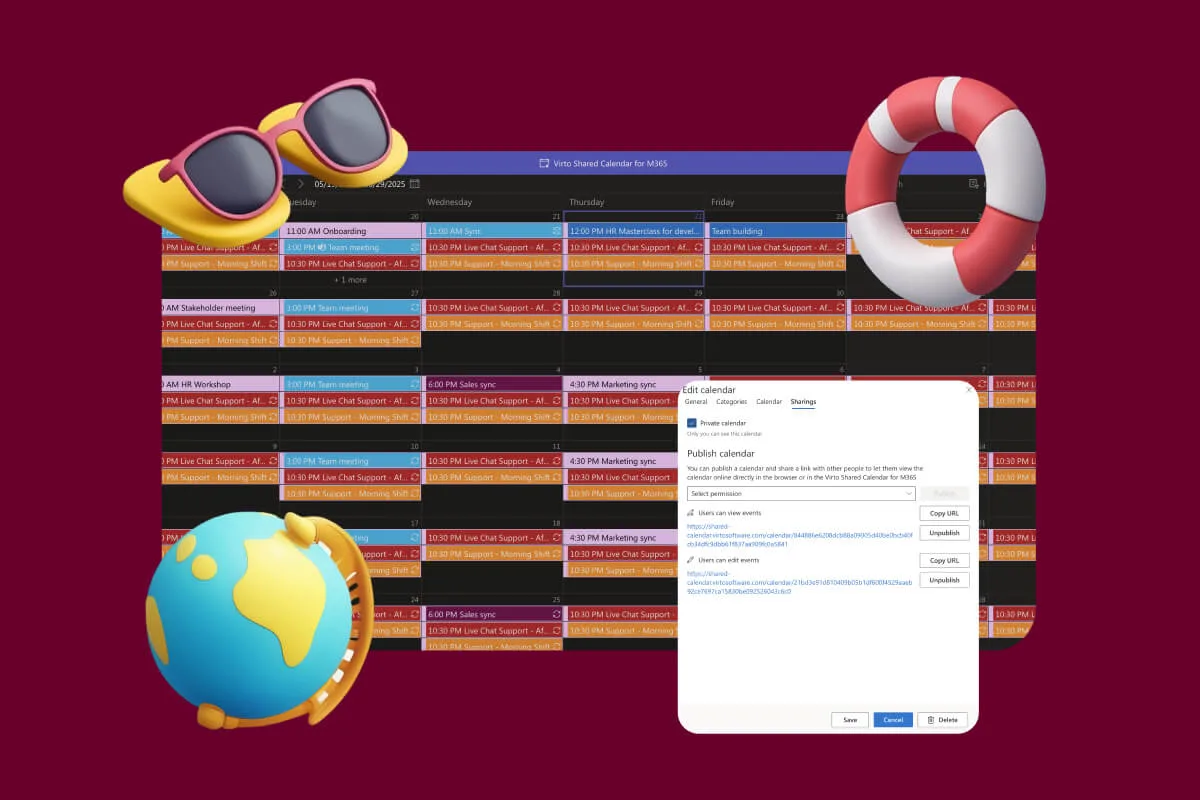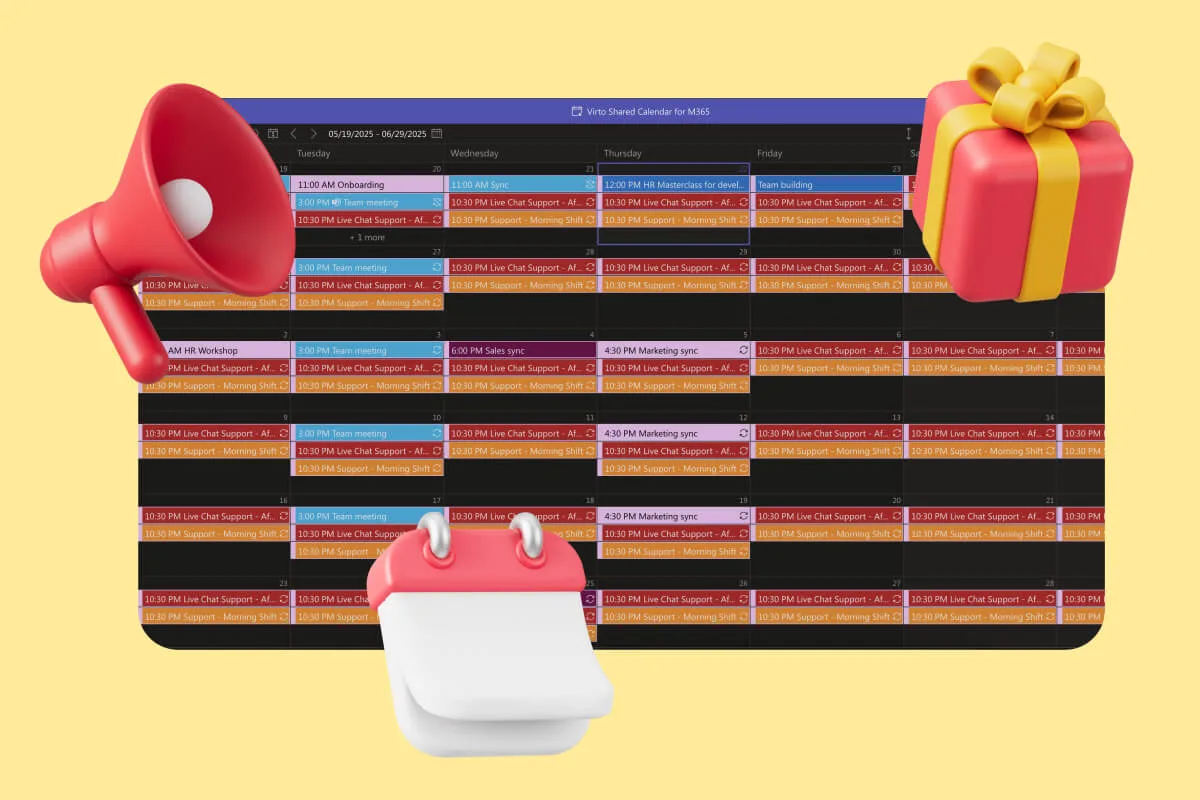Ever tried planning a team meeting, a family dinner, and your best friend’s birthday bash—all in the same week—without losing your mind? If you have, you already know the chaos that can come from playing calendar Tetris with multiple people. That’s where shared calendars swoop in like the scheduling superheroes they are.
Whether you’re juggling a team project at work, keeping the family on the same page, or managing events with friends, a calendar you can actually share (and everyone can update without a dozen back-and-forth messages) is a must.
In this article, we’re diving into the world of shareable calendars—what they are, why they’re awesome, and which platforms offer the best tools to make your scheduling life smoother. We’ll also walk you through how to create a shared calendar, use it like a pro, and choose the right setup whether you’re organizing business meetings or family pizza nights.
What Is a Shareable Calendar (And Why You’ll Wish You Started Using One Sooner)
Let’s clear the air—what exactly is a shareable calendar? No, it’s not just a fancy name for that dusty planner you forgot about in your desk drawer. A shareable calendar is a digital calendar you can create and share with others—friends, teammates, family, even your dog-walker if needed—so everyone’s in the loop about what’s happening and when.
But wait, isn’t that just a public calendar? Not quite.
A public calendar is like a bulletin board in the town square: anyone can see it (usually via a link or website widget), but no one can scribble on it except the creator. It’s great for announcing events, but not much help when you’re trying to collaborate on scheduling.
A shareable calendar, on the other hand, is more like a whiteboard in a shared office. You create a shared calendar and decide who gets to view it, who can edit it, and who has full control—like inviting people into your scheduling circle of trust. It’s perfect for teamwork, group planning, and generally avoiding the dreaded “Sorry, I thought that was next Tuesday” conversations.
Where shareable calendars really shine
So where does a calendar sharing earn its stripes? Pretty much anywhere people need to coordinate. Here are a few classic use cases:
- Personal life planning: Got a partner, bestie, or personal assistant? Share a calendar so you can easily schedule appointments, vacations, doctor visits, or dinner dates without the guesswork.
- Family stuff: Parents, unite! A shared family calendar can keep track of everything from soccer practice to school holidays to Aunt Linda’s birthday bash. Everyone’s plans, all in one place.
- Team projects at work: Shared calendars are a lifesaver for teams—especially remote or hybrid ones. Use them to sync meetings, track deadlines, and plan brainstorming sessions without the chaos of 30 Slack messages and three time zone calculators.
- Event or booking schedules: Coaches, consultants, event organizers—this one’s for you. Shareable calendars help you manage bookings, availability, and appointments with clients. No more double-booking or missed slots!
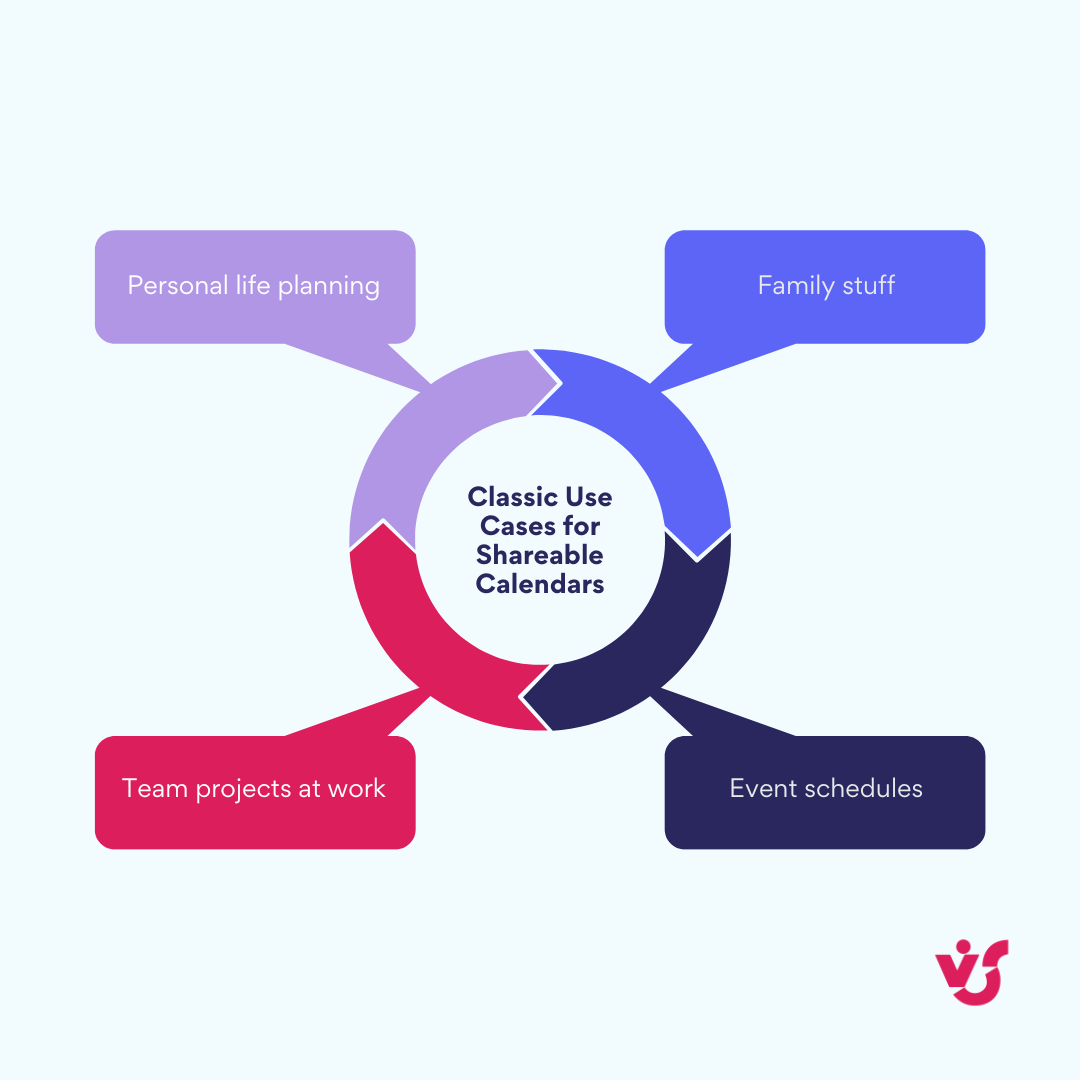
In short, a shareable calendar is like a backstage pass to better communication, smoother collaboration, and fewer scheduling headaches—whether you’re running a business, a family, or both.
No More “When Are You Free?”—Here’s Why Shared Calendars Rock
Let’s be real: trying to keep everyone on the same page (and at the same meeting) is hard enough without battling through endless email threads and “Wait, what time zone are you in again?” messages. That’s where shareable calendars absolutely shine. They’re not just handy—they’re your secret weapon for smoother teamwork, smarter scheduling, and less chaos all around.
The perks of using a shareable calendar
Let’s break it down—here’s how a shared calendar can seriously level up your game:
✅ Coordination without the back-and-forth.
No more ping-ponging messages to figure out who’s free when. Everyone can see what’s happening, when it’s happening, and who’s involved. It’s like mind-reading, but less creepy.
✅ Bye-bye, double bookings and missed calls.
When the whole crew uses the same calendar, you avoid those awkward “Oops, I thought you were free” overlaps. Plus, with notifications and reminders baked in, you’ll never miss another Monday stand-up (no promises about liking it, though).
✅ Full visibility = fewer surprises.
Need to check when that last sprint review happened? Or want to know what’s coming up next week? Shared calendars keep everything in plain sight. Great for managers, team leads, and anyone who hates surprises (unless it’s cake).
✅ Faster meeting planning.
No more “Does this work for you?” times ten. Just glance at everyone’s availability and book the slot. Instant scheduling zen.
✅ Project harmony.
Track milestones, release dates, and key deliverables in one shared space. Everyone knows where the train’s headed—and when.
✅ More engaged humans.
When people see the bigger picture, they feel more connected. A transparent online shareable calendar helps your team (or family!) stay aligned, motivated, and way less confused.
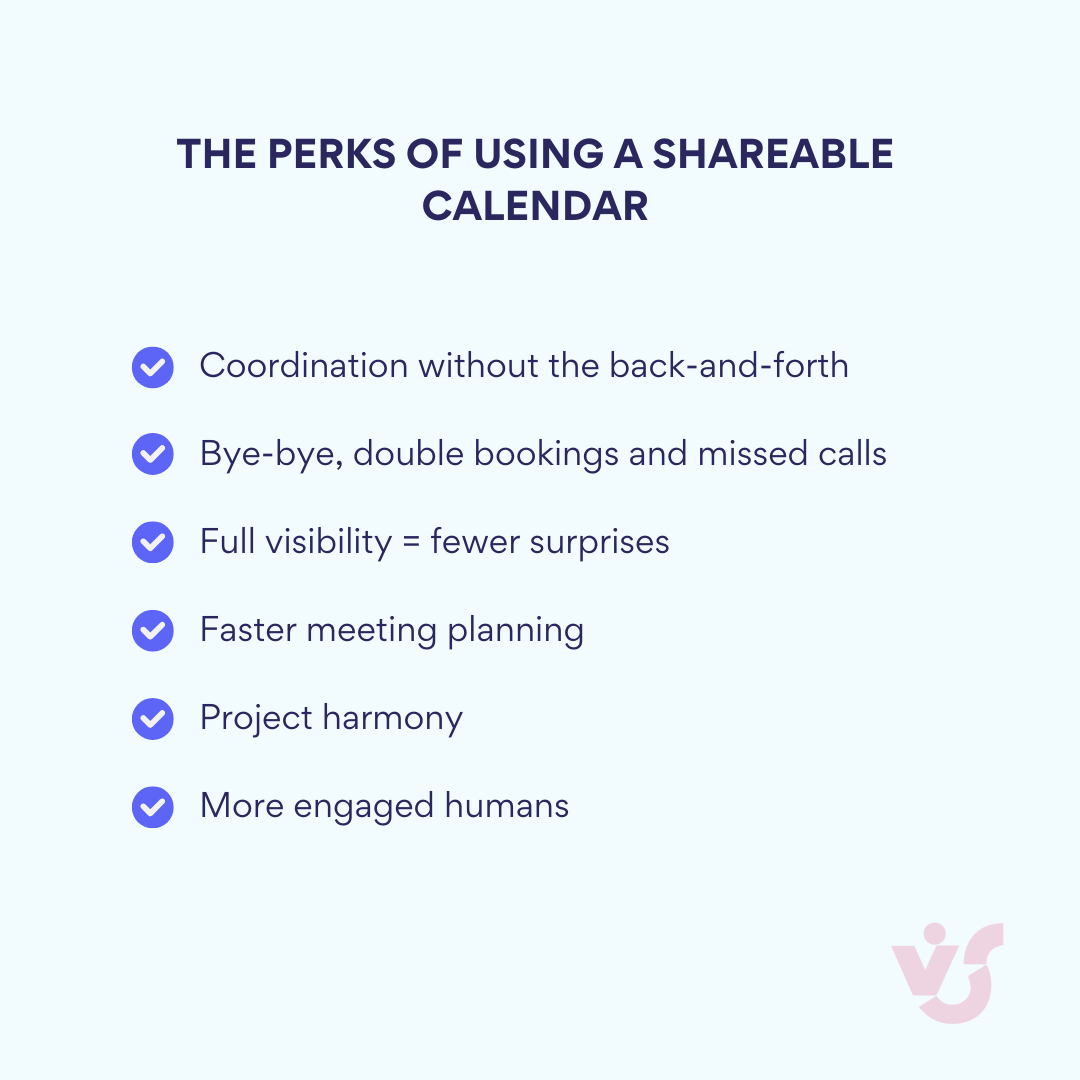
Real-world use cases: where shared calendars make magic happen
Not sure where a shared calendar would fit in your world? Here’s a little inspo from the trenches:
Marketing & content teams
- Mapping out blog drops, newsletters, and social media posts.
- Keeping everyone—from designers to copywriters—on the same page for campaign timelines.
- Giving agencies and freelancers access without the spreadsheet gymnastics.
Sales & customer support
- Booking demos, client calls, and follow-ups without missing a beat.
- Letting clients check manager availability and book meetings faster.
- Syncing up sales activities right inside your CRM calendar for smoother tracking.
Project teams (Dev, IT, Consulting, etc.)
- Visualizing sprints, deadlines, and task progress at a glance.
- Organizing your agile ceremonies—standups, retros, sprint planning—all in one place.
- Managing team workload and who’s working on what (and when).
Education & training
- Keeping track of classes, webinars, assignment due dates, and events.
- Sharing group calendars for students with live updates on class changes.
- Making sure nobody misses that pop quiz or surprise Zoom lecture.
HR & admins
- Managing vacation time, sick leaves, and shift schedules.
- Coordinating interviews and onboarding calendars for new hires.
- Keeping tabs on internal events: team buildings, workshops, birthdays—you name it.
Home & family life
- Sharing school schedules, sports practices, and dentist appointments.
- Coordinating shopping, errands, and family trips like a dream team.
- Planning birthdays, holidays, and taco nights with zero confusion.

Bottom line? Whether you’re running a team, a household, or both, a shareable calendar keeps life running smoothly—like a well-oiled scheduling machine (but way friendlier).
How to Make a Shared Calendar (and Actually Share It Like a Pro)
Okay, now that we’ve sold you on how awesome shared calendars are, let’s get into the how. Setting one up isn’t rocket science—and lucky for us, the big platforms have made the process pretty straightforward. Here’s your step-by-step guide to creating and sharing a calendar on two of the most popular tools: Google Calendar and Outlook/Microsoft 365.
Google Calendar: the crowd favorite
- Head over to Google Calendar.
- On the left sidebar, click the + next to “Other calendars” → then hit Create new calendar.
- Give your calendar a name, add a description (optional but nice), and set your time zone. Click Create calendar.
- Boom—it’s live. Now go to Settings for your shiny new calendar.
- Under Access permissions, you can:
- Make the calendar public (viewable by anyone) or shareable via a link.
- Decide if viewers can only see events or also make changes.
- Scroll down to Share with specific people:
- Add their email addresses.
- Choose their role: View only, Edit, or Full access (a.k.a. calendar boss).
Outlook / Microsoft 365: the workplace classic
- Open Outlook, switch to the Calendar view.
- Click Add calendar → choose Create blank calendar.
- Name it, pick a color (make it pretty), and choose where it lives (Outlook or shared group).
- Open sharing settings:
- Hit Share, enter email addresses of teammates or clients, and assign permissions.
- Decide who can just peek vs. who can plan.
- If you’re using Microsoft 365, you can:
- Share calendars with people inside or outside your org.
- Integrate the calendar into Teams or SharePoint for super-powered collaboration.
👉Neither Google Calendar or Outlook works for you? Check out our guide on How To Create a Shared Calendar in Microsoft Teams
👉How to create a shared calendar? To create a shared calendar, start by choosing your platform—Google Calendar and Outlook are two of the most popular. In Google Calendar, go to calendar.google.com, click the “+” next to “Other calendars,” and select “Create new calendar.” Name it, set your time zone, and once created, open its settings to share it via email (with view or edit permissions) or by generating a shareable link. In Outlook, go to the Calendar view, click “Add calendar” → “Create blank calendar,” name it, and use the “Share” option to invite people and set their access level. Both tools also support embedding your calendar on a website for public access if needed.
Improve Your Shareable Calendar with Virto Apps
How to share calendar (because it’s not a secret)
Now that your calendar is looking fresh and organized, how do you actually get it into other people’s hands?
✅ Share by email
Just add the email addresses of your collaborators when setting up sharing. They’ll get an invite, and boom—they’re in. Great for private or internal sharing.
🔗 Share via link
In Google Calendar, you can generate a shareable link (view-only or editable). Perfect for quick sharing in emails, group chats, or internal docs.
Heads up: anyone with the link can access it—so double-check those privacy settings.
🌐 Embed it on a website
Google Calendar lets you grab an HTML embed code to stick the calendar right on your website.
Customize how it looks (month view, agenda style, etc.) and control what info shows up.
Ideal for schools, clubs, event organizers—anyone with a public schedule to share.
The Best Shared Calendar Apps to Create and Share a Calendar (Without Breaking a Sweat)
Looking for the perfect calendar sharing app to keep your schedule (and your people) on track? Whether you’re planning office meetings, family birthdays, or a multi-team product launch, there’s a shared calendar app out there with your name on it. Here’s a quick roundup of the top players and what makes each one tick.
| Tool | Interface | Sharing & Access | Sync & Integrations | Pricing |
| Google Calendar | Simple, intuitive, user-friendly | Email, link, embed; view/edit/admin roles | Syncs with Gmail, Meet, Android/iOS; integrates with many apps | Free (Google); Paid via Workspace |
| Outlook (365) | Corporate, polished | Internal & external sharing; role-based access | Syncs with Teams, Outlook; strong Microsoft 365 ecosystem links | Free personal; Paid 365 plans |
| iCloud Calendar | Minimalist, Apple-style | Share via email or iCloud link (Apple users) | Syncs across Apple devices; limited to Apple ecosystem | Free with iCloud |
| Teamup Calendar | Color-coded, clean | Share via link; custom access per link | Web-based; iCal feeds; basic integrations | Free basic; Paid plans available |
| Zoho Calendar | Functional, business-oriented | Team/public sharing; role-based access | Sync via CalDAV; best with Zoho suite | Free with Zoho; Paid tiers |
| Trello (Calendar View) | Task board with calendar view | Share board; calendar shows due dates | Export to iCal; many Power-Up integrations | Free basic; Paid for extras |
| Virto Shared Calendar | Visual, customizable | Advanced sharing across M365 users/groups | Deep integration with SharePoint, Teams | Paid app with free trial |
👉Stick around — we’ve got more insights, tools, and “why didn’t I try this sooner?” tips in our article – 11 Best Shared and Collaborative Calendar Apps for Business Needs
What’s the best shareable calendar app?
Short answer: it depends on your vibe.

How to Choose the Right Shareable Calendar for Your Life
So many online shared calendars, so little time—literally. Whether you’re trying to wrangle a family of five, sync a remote dev team, or just stop missing your dentist appointments, picking the best shared calendar can make your daily chaos a lot more manageable. Here’s how to choose the perfect fit based on your needs.
👨👩👧👦 For Family & Personal Life
Want to stop texting “when’s the parent-teacher meeting again?” every other week? Go for something simple and reliable:
- Google Calendar – Easy to use, works on any device, and you can share it with the whole family in just a few taps. Add birthdays, school runs, and even your dog’s grooming appointments and share a Google calendar with everyone involved..
- iCloud Calendar – If your crew lives in the Apple ecosystem, this one’s a breeze. Integrated with iPhones, iPads, Macs—and thanks to Family Sharing, everyone stays on the same page without group chat drama.
🏢 For the Corporate World
When you’re juggling departments, deadlines, and data security, your calendar needs to be a team player:
- Outlook Calendar (Microsoft 365) – A classic for a reason. Offers detailed permission settings, perfect for large teams. Bonus: plays nice with Teams, Exchange, and SharePoint.
- Microsoft Teams + Virto Shared Calendar App – For power users. Keep your schedule right inside Teams, organize by department or project, and control who sees what. No tab overload, no extra logins.
🧑🎨 For Temporary Projects & Events
Running a club? Organizing a one-time event? You’ll want something lightweight, fast, and easy to share:
- Teamup Calendar – No login required to view. Color-code categories, share via link, and keep your event group in sync without the email ping-pong.
- Trello + Calendar Power-Up – Perfect for casual projects where tasks need deadlines. Add a calendar view to your board and see everything laid out beautifully.
⏰ For Scheduling with Reminders
When your day’s packed with meetings, calls, or client sessions, reminders are your best friend:
- Calendly – Create a public booking page, set your availability, and let people pick a time that works. Syncs with Google and Outlook—no more back-and-forth scheduling.
- Zoho Calendar – Part of the Zoho suite, so if your business already runs on Zoho, this keeps everything in one neat place. Great for small teams and solo consultants.
Explore Our Use Cases for Shareable Calendar
What to look for when choosing your calendar
Here’s your cheat sheet for picking the right one:
- Access control – Can you give people different roles? (Just viewing vs. full editing powers?) This is key if you’re working in teams or sharing publicly.
- User-friendly interface – The easier it is to add events or change settings, the more people will actually use it. No one likes a clunky calendar.
- Integrations – Look for sync with tools you already use: Google Workspace, Microsoft 365, CRMs, Slack, Teams… you get the idea.
- Reminders & notifications – Whether it’s a gentle nudge via email or a “GET TO THAT MEETING” push alert, good reminders = fewer missed deadlines.
- Mobile access – A must-have. If you can’t check or edit your calendar on the go, it’s basically useless in 2025.
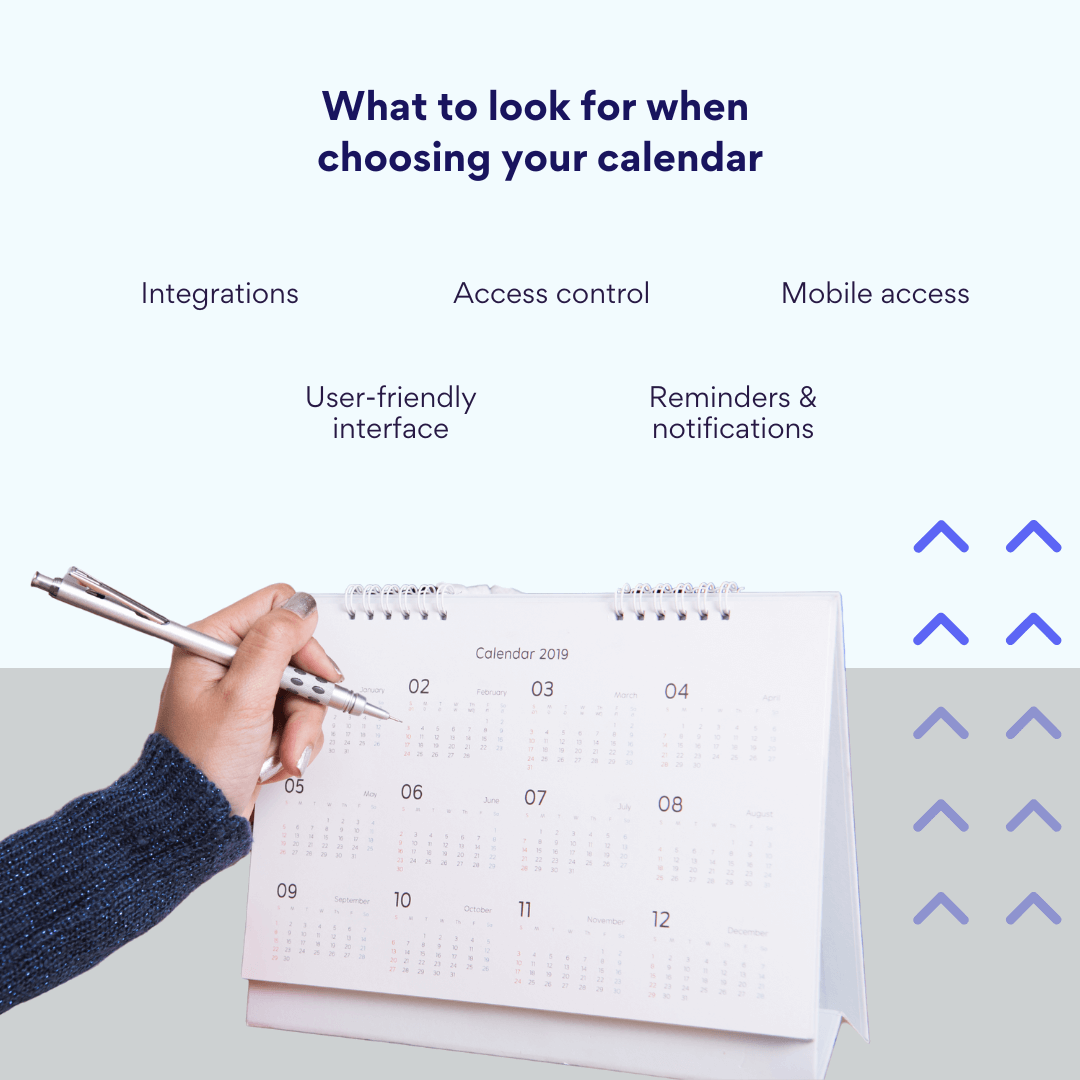
📌 Pro tip: Try a few! Most of these tools are free to start with, so don’t be afraid to experiment until you find the one that clicks with your workflow.
Virto Shared Calendar App for Microsoft Teams — A Team Player’s Dream
If your organization runs on Microsoft 365 and you’re still juggling multiple calendars like it’s 2012—it’s time to upgrade your game. Enter Virto Shared Calendar App: the calendar superpower you didn’t know you needed inside Microsoft Teams.
🎯 What makes Virto Shared Calendar so cool?
It’s not just another calendar. Virto brings everything together in one sleek, powerful interface—no switching tabs, no digging through emails, no “what time zone are you in again?” chaos. Here’s what it does best:
- Microsoft-native integration – Virto plays nicely with Teams, Outlook, and SharePoint, so your whole ecosystem stays in sync without any messy add-ons or workarounds.
- Collaborative scheduling – whether it’s meetings, deadlines, events, or team check-ins, everyone can stay on the same page—literally. Just drop it into your Teams tab and start planning like pros.
- Custom access levels – give the marketing team editing power, let sales view only, and keep admin control where it belongs. You call the shots.
- Multiple calendar views – zoom in on today’s madness, glide through the week, or map out the month—Virto supports all standard views to match your style.
- Time zone savvy – distributed team? No sweat. Everyone sees events in their local time, no manual math required. Goodbye, scheduling headaches.
💡 Why teams love Virto Shared Calendar
Here’s why this app might just become your team’s new favorite coworker:
✅ Works right inside Microsoft Teams — No extra tabs, no browser hopping.
✅ Quick event creation — Add meetings on the fly, apply color-coded filters, and keep things tidy.
✅ Centralized calendar management — Organize by department, project, or initiative. Everything in one place = peace of mind.
✅ Versatile for every team — From Agile sprints to HR onboarding to office party planning, Virto flexes to fit your flow.
Whether you’re leading a project, managing a department, or just trying to keep a fast-moving team aligned, Virto Shared Calendar App gives you that bird’s-eye view you’ve been craving—with zero chaos and a whole lot of control.
Wrapping It Up: Why Shareable Calendars Just Make Sense
Let’s be real — planning is hard enough without five different threads, three missed invites, and one “Oh no, that was today?” moment. That’s where shareable calendars come to the rescue. They smooth out team communication, boost transparency, reduce double-bookings, and help everyone stay in sync without the chaos.
Thanks to today’s smart tools, you can build and share calendar that is as flexible as your workflow — with custom access levels, secure sharing via link or email, and even public embeds for events and schedules. Whether you’re planning a product launch or a pizza night, there’s a tool to make it seamless.
And if your team is living the Microsoft 365 life, we’ve got to say — the Virto Shared Calendar App is a total game-changer. It slots right into Microsoft Teams, gives you centralized control over all your calendars (hello, clarity!), and syncs effortlessly with Outlook and SharePoint. Bonus: you can manage project timelines, team events, and department schedules without ever leaving Teams.
Better calendars = better teamwork. So go ahead — give Virto Shared Calendar App a spin and turn planning from a pain into pure productivity.
👉If this article got your gears turning, don’t stop here — we’ve got more calendar gold waiting for you.

